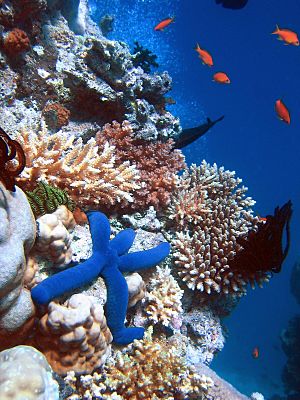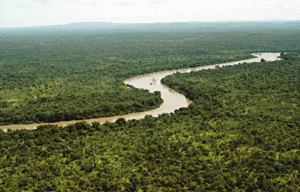Ecosystem

An ecosystem is like a big neighborhood where living things and their environment work together. It includes all the plants, animals, and tiny microbes in a specific area. These living parts are connected to the non-living parts, like water, soil, and air. They share nutrients and energy, making the whole system run.
Ecosystems can be any size. For example, a small aquarium is an ecosystem with fish and plants. A huge desert is also an ecosystem, home to cacti, snakes, and scorpions. Even a pond with frogs and insects, or a forest with rabbits and pine trees, are all examples of different ecosystems. Each one has its own unique community of living things.
Contents
How Ecosystems Get Energy
Ecosystems are usually stable, but they can change over time. They react to big shifts in their environment, especially climate change. For instance, rainforests have existed for millions of years. When the rainfall or temperature changes, the rainforests also change. We know that the Amazon rainforest got smaller during ice ages and grew larger in warmer times.
How Ecosystems Make Food
All ecosystems rely on something called primary production. This is how living things create their own food. It mainly happens through a process called photosynthesis. Photosynthesis is when plants use sunlight to turn carbon dioxide and water into food (sugars) and oxygen.
This process is super important because it drives the carbon cycle. The carbon cycle affects our global climate through the greenhouse effect.
The total amount of food made by all plants in an ecosystem is called gross primary production (GPP). Plants use some of this food for their own energy, which is called respiration. The food that is left over is known as net primary production (NPP). Many things can limit how much food plants can make. These include how much light is available, how much carbon dioxide and water they can get, and if the temperature is right.
Types of Ecosystems
There are many different kinds of ecosystems around the world. They can be grouped into two main types:
- Aquatic ecosystems (water-based)
- Marine ecosystems (like oceans, coral reefs, and estuaries)
- Freshwater ecosystems (like rivers, lakes, and ponds)
- Terrestrial ecosystems (land-based)
- Forests
- Deserts
- Grasslands
- Tundra (cold, treeless areas)
- Taiga (boreal forests)
Related topics
Images for kids
-
Flora of Baja California Desert, Cataviña region, Mexico
-
Loch Lomond in Scotland is a somewhat isolated ecosystem. Its fish community was stable for a long time until new species were introduced in the 1970s.
-
A spiny forest in Madagascar, with unique trees like Adansonia (baobab) and Alluaudia procera.
-
The High Peaks Wilderness Area in the 6,000,000-acre (2,400,000 ha) Adirondack Park is a great example of a diverse ecosystem.
See also
 In Spanish: Ecosistema para niños
In Spanish: Ecosistema para niños











